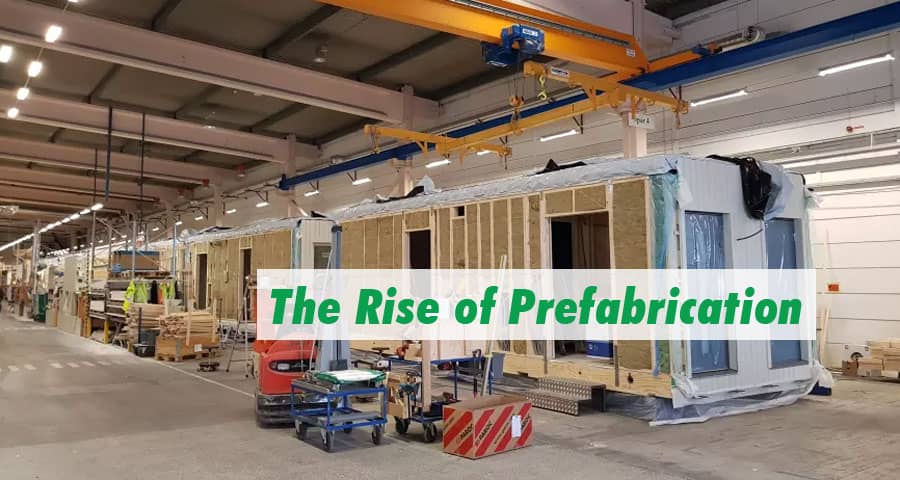The Rise of Prefabrication: Modern Tools for Off-Site Construction

Introduction
In the dynamic realm of construction, a revolutionary shift is occurring with the rise of prefabrication.
- Definition of Prefabrication: Prefabrication, commonly known as prefab, involves the assembly of building components off-site before transporting and installing them on-location. This innovative construction approach challenges traditional methods, offering unparalleled efficiency and flexibility.
- Growing Trends in Off-Site Construction: The construction industry is witnessing a paradigm shift as off-site construction gains momentum. The increased demand for rapid, cost-effective building solutions is propelling the adoption of prefabrication techniques globally.
- Significance of Modern Tools in Prefabrication: Modern tools play a pivotal role in reshaping prefabrication. From cutting-edge design software to robotics, these tools are redefining how structures are built, emphasizing precision, speed, and sustainability.
Historical Context
- Evolution of Prefabrication Techniques: The roots of prefabrication trace back centuries, but recent decades have seen a surge in innovation. Early modular construction paved the way for today's sophisticated off-site assembly methods.
- Milestones in Off-Site Construction: Landmark projects, such as the modular construction of residential towers, showcase the industry's ability to embrace innovation. These milestones highlight the efficiency and scalability of prefabrication.
- Impact on Construction Industry: Prefabrication has not only streamlined construction processes but has also influenced industry standards. The efficiency gains are driving a shift towards sustainable and eco-friendly building practices.
Advantages of Prefabrication
- Cost Efficiency: Prefabrication significantly reduces construction costs through optimized material usage, minimized waste, and accelerated project timelines. The controlled factory environment further contributes to cost savings.
- Time-Saving: Off-site construction enables parallel work streams, drastically reducing project timelines. Modern tools facilitate precision and speed, allowing for the rapid assembly of components.
- Environmental Benefits: The environmental impact of traditional construction is a growing concern. Prefabrication addresses this by minimizing waste, reducing energy consumption, and promoting sustainable building practices.
- Quality Control: Factory-controlled conditions ensure consistent quality in prefabricated components. Rigorous testing and quality control measures enhance the durability and reliability of structures.
Modern Tools in Prefabrication
- Advanced Design Software: Sophisticated design software enables architects and engineers to create intricate prefabricated components. This enhances customization, precision, and the seamless integration of various building elements.
- Robotics and Automation: Robotics and automation in manufacturing processes improve efficiency and accuracy. From welding to assembly, these technologies streamline production, minimizing human error and maximizing output.
- 3D Printing in Construction: The advent of 3D printing has revolutionized prefabrication. Printing structural components with precision and speed opens new possibilities in design and construction, pushing the boundaries of traditional methods.
- Smart Materials: Incorporating smart materials, such as self-healing concrete and energy-efficient insulation, enhances the functionality and sustainability of prefabricated structures. These materials contribute to long-term cost savings and reduced environmental impact.
Case Studies
- Successful Projects Utilizing Prefabrication: Exploring case studies of iconic projects, like modular skyscrapers and prefab housing developments, showcases the success and potential of prefabrication. These examples provide insights into the practical applications of modern tools.
- Industry Leaders Embracing Modern Tools: Leading construction companies are embracing modern tools to stay at the forefront of the industry. Collaboration with technology providers and investing in research and development ensures continuous innovation.
Challenges and Solutions
- Addressing Misconceptions: Prefabrication faces misconceptions regarding quality and design limitations. Addressing these concerns through education and showcasing successful projects can dispel myths and encourage wider adoption.
- Overcoming Resistance in the Industry: Tradition often meets resistance to change. Overcoming skepticism in the construction industry involves demonstrating the proven benefits of prefabrication, backed by data and real-world examples.
- Future Innovations in Prefabrication: Constant innovation is the key to the future of prefabrication. Anticipating challenges and proactively developing solutions will drive the industry forward. Collaborative efforts between stakeholders will foster a culture of continuous improvement.
Future Outlook
- Emerging Technologies in Off-Site Construction: As technology continues to evolve, new tools and techniques will emerge, further enhancing the capabilities of prefabrication. From advanced robotics to sustainable materials, the future promises unprecedented possibilities.
- Potential Impact on Traditional Construction Methods: The widespread adoption of prefabrication may reshape traditional construction methods. The efficiency, sustainability, and cost-effectiveness of off-site construction could become the new standard in the industry.
- Global Adoption of Prefabrication: The global construction landscape is witnessing a shift towards prefabrication. As more countries embrace this innovative approach, the industry's carbon footprint may decrease, and construction timelines may shorten on a global scale.
Conclusion
In conclusion, the rise of prefabrication, coupled with modern tools, is revolutionizing the construction industry. The advantages of cost efficiency, time-saving, and environmental benefits, paired with the integration of advanced technologies, signal a transformative era in building practices.
FAQs
Is prefabrication suitable for all types of construction projects?
Prefabrication is versatile and can be applied to various construction projects, from residential buildings to commercial structures.
How does prefabrication contribute to sustainability?
Prefabrication reduces waste, optimizes material usage, and promotes energy-efficient practices, making it an environmentally friendly construction method.
What challenges does the construction industry face in adopting prefabrication?
Resistance to change, misconceptions about quality, and the need for standardized regulations are some challenges hindering the widespread adoption of prefabrication.
Are there any limitations to the use of modern tools in prefabrication?
While modern tools enhance efficiency, they may require specialized skills and initial investment, posing challenges for smaller construction firms.
What role does 3D printing play in the future of prefabrication?
3D printing opens new possibilities in design and construction, allowing for the creation of complex and customized structural components with speed and precision.
